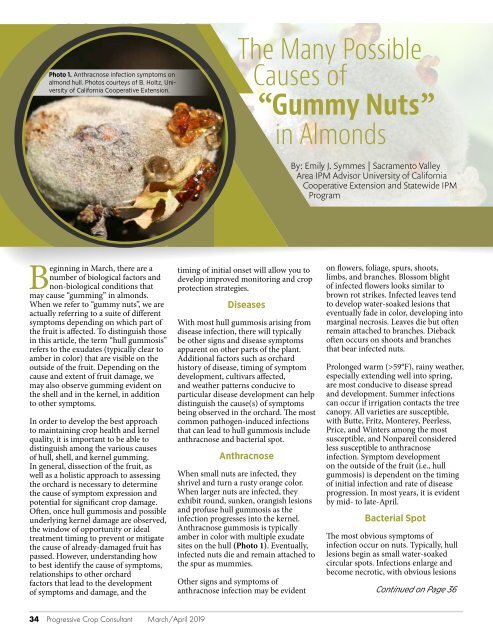PCC March 2019
You also want an ePaper? Increase the reach of your titles
YUMPU automatically turns print PDFs into web optimized ePapers that Google loves.
Photo 1. Anthracnose infection symptoms on<br />
almond hull. Photos courteys of B. Holtz, University<br />
of California Cooperative Extension.<br />
The Many Possible<br />
Causes of<br />
“Gummy Nuts”<br />
in Almonds<br />
By: Emily J. Symmes | Sacramento Valley<br />
Area IPM Advisor University of California<br />
Cooperative Extension and Statewide IPM<br />
Program<br />
Beginning in <strong>March</strong>, there are a<br />
number of biological factors and<br />
non-biological conditions that<br />
may cause “gumming” in almonds.<br />
When we refer to “gummy nuts”, we are<br />
actually referring to a suite of different<br />
symptoms depending on which part of<br />
the fruit is affected. To distinguish those<br />
in this article, the term “hull gummosis”<br />
refers to the exudates (typically clear to<br />
amber in color) that are visible on the<br />
outside of the fruit. Depending on the<br />
cause and extent of fruit damage, we<br />
may also observe gumming evident on<br />
the shell and in the kernel, in addition<br />
to other symptoms.<br />
In order to develop the best approach<br />
to maintaining crop health and kernel<br />
quality, it is important to be able to<br />
distinguish among the various causes<br />
of hull, shell, and kernel gumming.<br />
In general, dissection of the fruit, as<br />
well as a holistic approach to assessing<br />
the orchard is necessary to determine<br />
the cause of symptom expression and<br />
potential for significant crop damage.<br />
Often, once hull gummosis and possible<br />
underlying kernel damage are observed,<br />
the window of opportunity or ideal<br />
treatment timing to prevent or mitigate<br />
the cause of already-damaged fruit has<br />
passed. However, understanding how<br />
to best identify the cause of symptoms,<br />
relationships to other orchard<br />
factors that lead to the development<br />
of symptoms and damage, and the<br />
timing of initial onset will allow you to<br />
develop improved monitoring and crop<br />
protection strategies.<br />
Diseases<br />
With most hull gummosis arising from<br />
disease infection, there will typically<br />
be other signs and disease symptoms<br />
apparent on other parts of the plant.<br />
Additional factors such as orchard<br />
history of disease, timing of symptom<br />
development, cultivars affected,<br />
and weather patterns conducive to<br />
particular disease development can help<br />
distinguish the cause(s) of symptoms<br />
being observed in the orchard. The most<br />
common pathogen-induced infections<br />
that can lead to hull gummosis include<br />
anthracnose and bacterial spot.<br />
Anthracnose<br />
When small nuts are infected, they<br />
shrivel and turn a rusty orange color.<br />
When larger nuts are infected, they<br />
exhibit round, sunken, orangish lesions<br />
and profuse hull gummosis as the<br />
infection progresses into the kernel.<br />
Anthracnose gummosis is typically<br />
amber in color with multiple exudate<br />
sites on the hull (Photo 1). Eventually,<br />
infected nuts die and remain attached to<br />
the spur as mummies.<br />
Other signs and symptoms of<br />
anthracnose infection may be evident<br />
on flowers, foliage, spurs, shoots,<br />
limbs, and branches. Blossom blight<br />
of infected flowers looks similar to<br />
brown rot strikes. Infected leaves tend<br />
to develop water-soaked lesions that<br />
eventually fade in color, developing into<br />
marginal necrosis. Leaves die but often<br />
remain attached to branches. Dieback<br />
often occurs on shoots and branches<br />
that bear infected nuts.<br />
Prolonged warm (>59°F), rainy weather,<br />
especially extending well into spring,<br />
are most conducive to disease spread<br />
and development. Summer infections<br />
can occur if irrigation contacts the tree<br />
canopy. All varieties are susceptible,<br />
with Butte, Fritz, Monterey, Peerless,<br />
Price, and Winters among the most<br />
susceptible, and Nonpareil considered<br />
less susceptible to anthracnose<br />
infection. Symptom development<br />
on the outside of the fruit (i.e., hull<br />
gummosis) is dependent on the timing<br />
of initial infection and rate of disease<br />
progression. In most years, it is evident<br />
by mid- to late-April.<br />
Bacterial Spot<br />
The most obvious symptoms of<br />
infection occur on nuts. Typically, hull<br />
lesions begin as small water-soaked<br />
circular spots. Infections enlarge and<br />
become necrotic, with obvious lesions<br />
Continued on Page 36<br />
34 Progressive Crop Consultant <strong>March</strong>/April <strong>2019</strong>


















